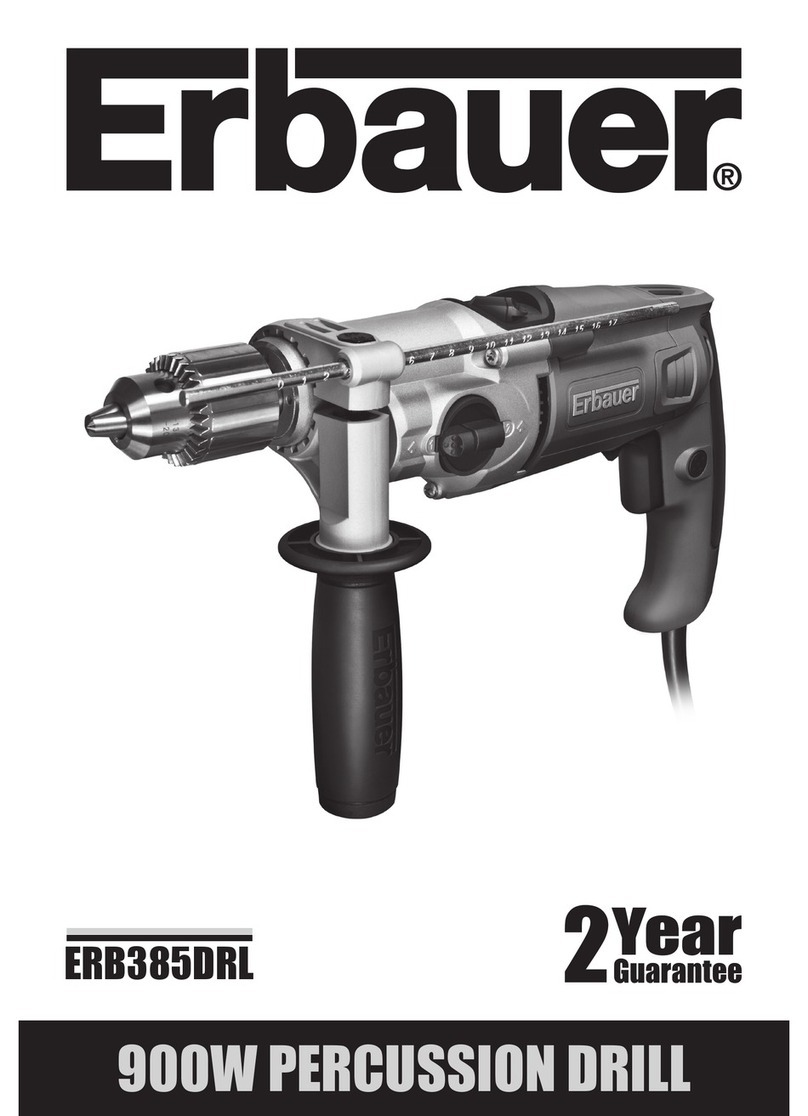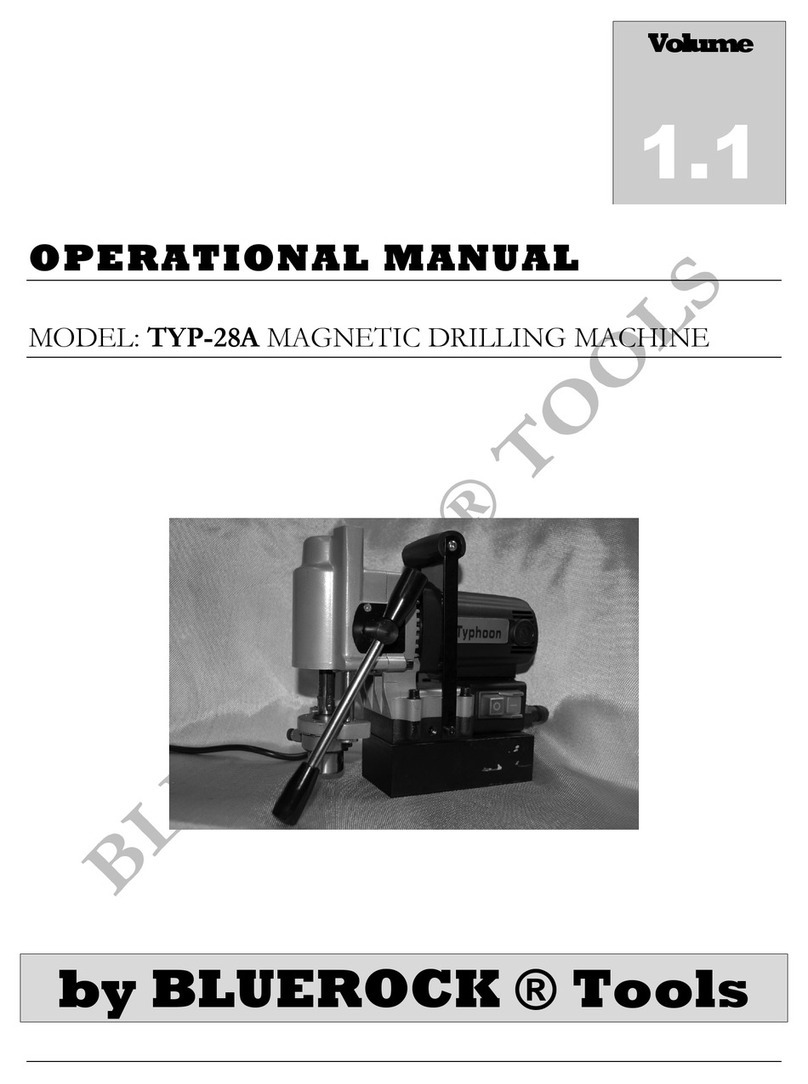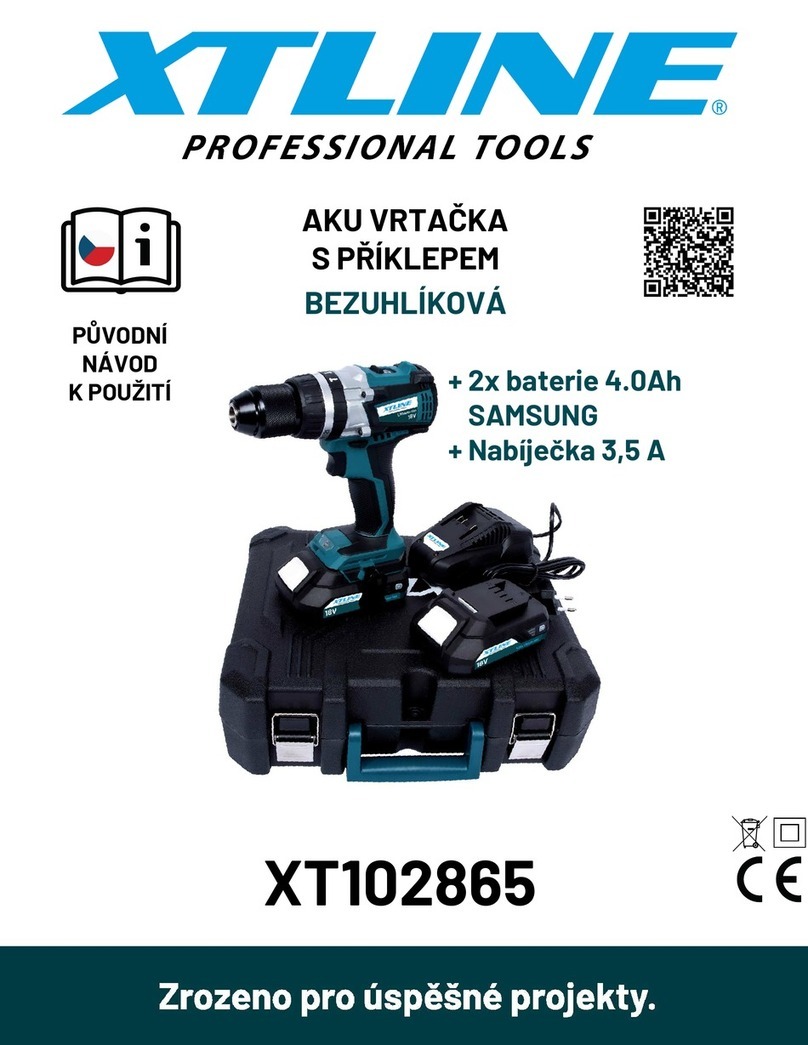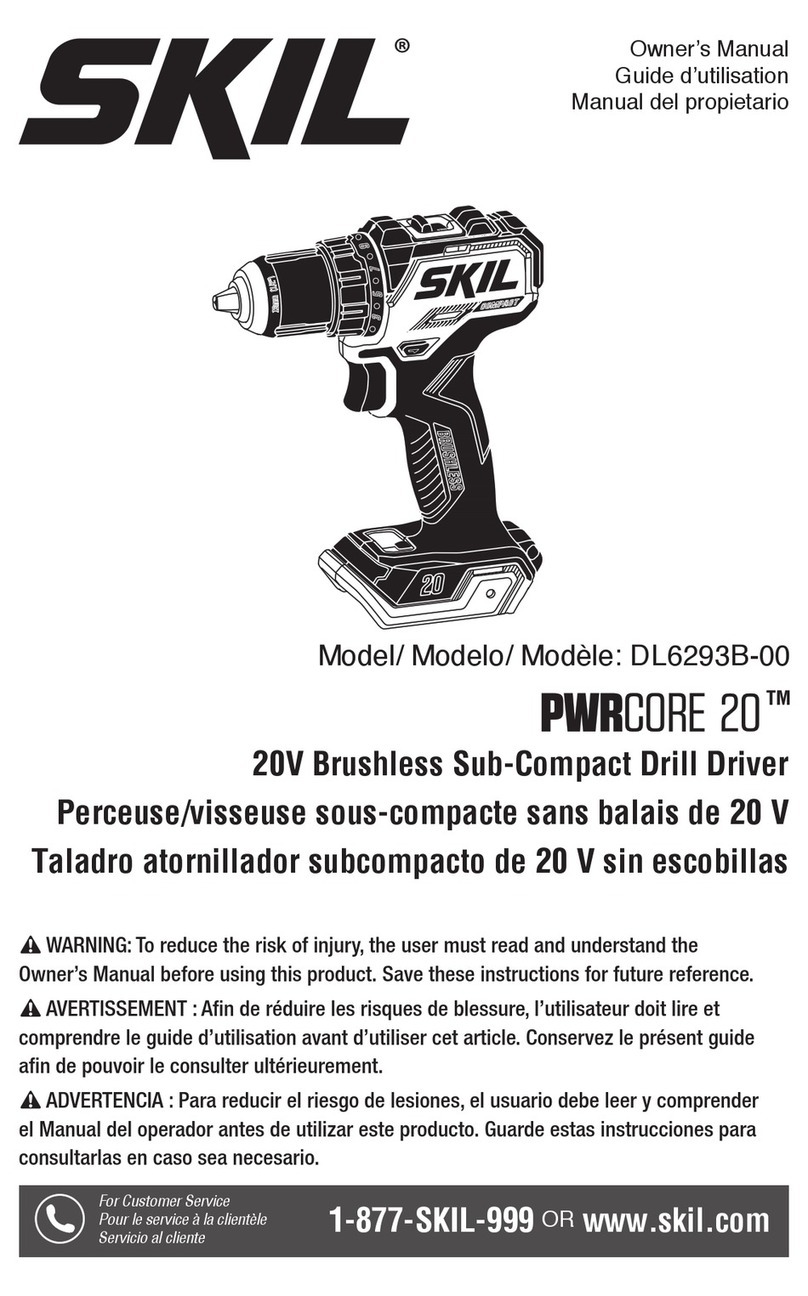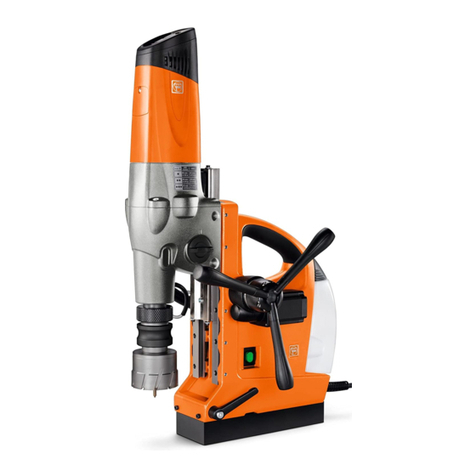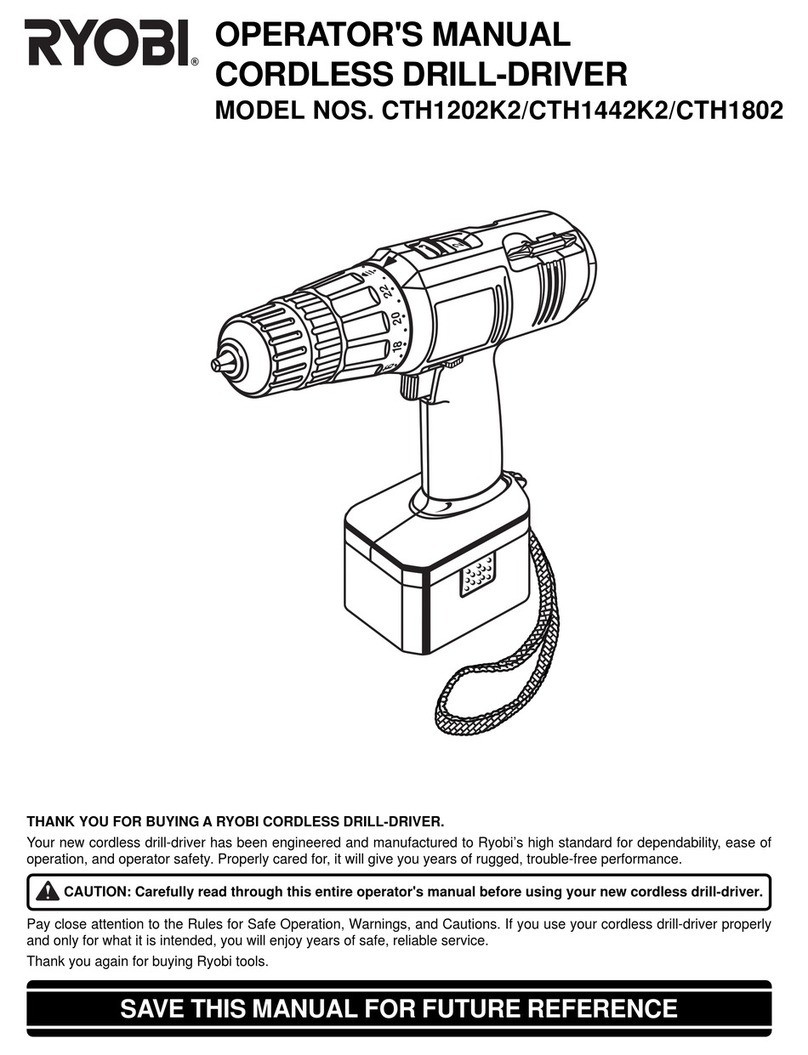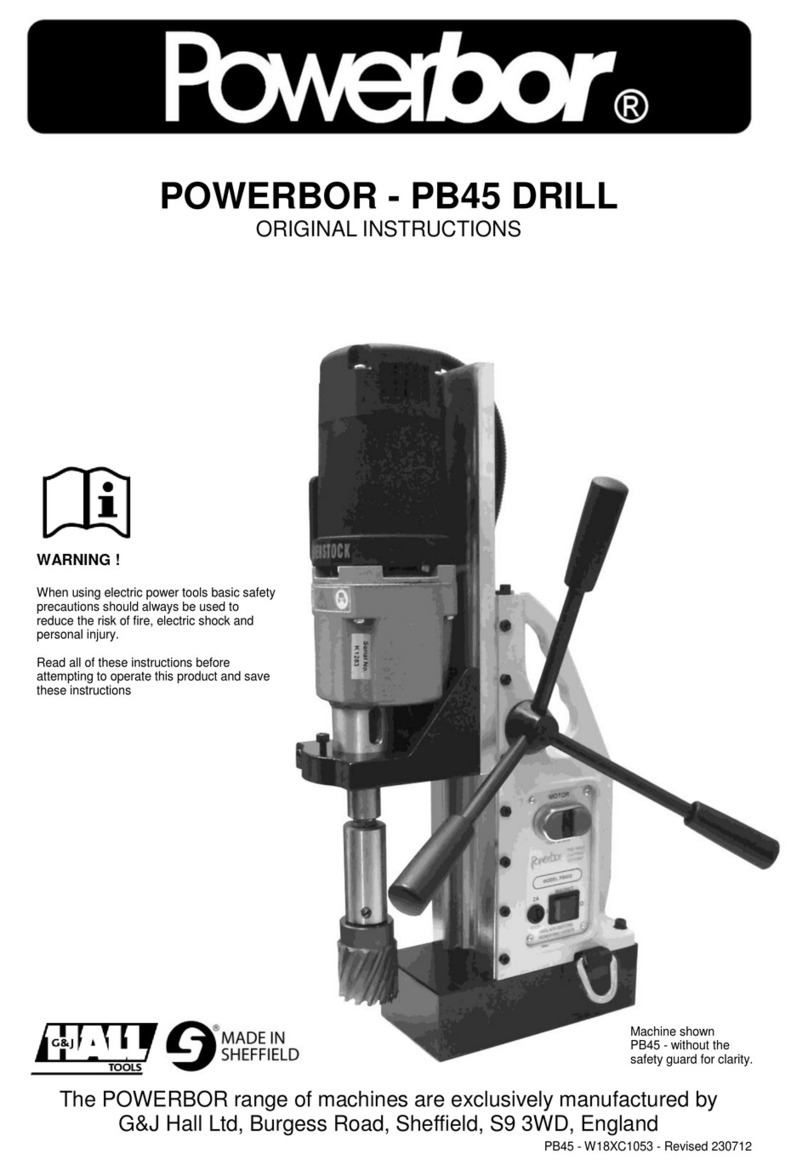Blohm + Voss Oil Tools GraySpin Mark 40 Guide

1
Blohm + Voss Oil Tools, LLC
GraySpin Mark 40
Hydraulic Drill Pipe Spinner
With and without Hydraulic Lift
Technical Documentation

2
Warnings and Notes
WARNING: A “WARNING”
INDICATES A DEFINITE
RISK OF EQUIPMENT
DAMAGE OR DANGER TO
PERSONNEL. FAILURE TO
OBSERVE AND FOLLOW
PROPER PROCEDURES
COULD RESULT IN SERIOUS
OR FATAL INJURY TO
PERSONNEL, SIGNIFICANT
PROPERTY LOSS, OR
SIGNIFICANT EQUIPMENT
DAMAGE.
NOTE: A “NOTE” indicates
that additional information is
provided about the current
topics.
Intended use of this
manual
WARNING: THIS TECHNICAL
DOCUMENTATION CONTAINS
INSTRUCTIONS ON SAFETY,
INSTALLATION, OPERATION
AND MAINTENANCE. IT
MUST BE STUDIED BEFORE
WORKING WITH THE TOOL.
This manual is
intended for use by eld
service, engineering,
installation, operation, and
repair personnel. Every
effort has been made to
ensure the accuracy of the
Manufacturer & Agents World Wide
information contained herein.
Blohm + Voss Oil Tools, LLC,
will not be held liable for
errors in this material, or for
consequences arising from
misuse of this material.
Anyone using service
procedures or tools, whether
or not recommended by
Blohm + Voss Oil Tools, LLC,
must be thoroughly satised
that neither personal safety
nor equipment safety will be
jeopardized.
Intellectual property
All rights retained.
No part of this document
may be reproduced in any
form (print, photocopy,
microlm or any other
procedure) or be processed
using an electronic system
without written approval of
Blohm + Voss Oil Tools, LLC
All information
contained in this manual
is based upon the latest
product information available
at the time of printing.
Dependent on ongoing
technical improvements
(ISO 9001) “Blohm + Voss
Oil Tools, LLC” reserves the
right to change the design
and specications without
announcement.
The values specied in
this manual represent the
nominal values of a unit
produced in series. Slight
deviations in the case of
the individual devices are
possible.
NOTE: In the event of
problems that cannot be
solved with the aid of this
manual, please contact
one of the addresses listed
below.
General remarks
As with all rig
equipment, the Mark
40 must be operated in
accordance with accepted
rig safety practices and
procedures. All operators
should be familiar with all
safety precautions and
recommended installation
and operating procedures,
including the information
provided in this manual and
any other safety publications
by Blohm+Voss Oil Tools,
LLC. Listed on the next page
are safety considerations
and warnings found
throughout this manual.
Limited Warranty
The warranty provided will
be void if the Mark 40 is:
1. The unit was repaired
or serviced by a
service facility which
was not authorized by
Blohm+Voss Oil Tools,
LLC.
2. The replacement parts
were not manufactured
by Blohm + Voss Oil
Tools, LLC are used.
3. The modications were
made to the Mark 40
which was not approved
by Blohm + Voss Oil
Tools, LLC.
Premier Sea & Land Pte Ltd
54 Loyang Way
Singapore 508747
Phone: +65-6543-1433
Fax: +65-6543-1219
enquiries@mtqpremier.com.sg
HI-Energy Service
Hamriyah Free Zone
Sharjah, UAE
Phone: +971-55-2308-252
Fax: +971-4-2980-862
bdm@hi-energyservices.com
Blohm + Voss is a trademark of Blohm + Voss Shipyards GmbH®
Blohm + Voss Oil Tools GmbH
Hermann-Blohm-Straße 2
20457 Hamburg
Germany
Phone: +49-40-3119-1162
Fax: +49-40-3119-8196
oiltools@blohmvoss.com
www.blohmvoss-oiltools.com
Blohm + Voss Oil Tools, LLC
11355 FM 830
Willis, Texas 77318
United States of America
Phone: +1-936-856-4995
Fax: +1-936-856-7487
BVOT@blohmvoss.com
www.blohmvoss-oiltools.com
GENERAL INFORMATION

3
Safety issues
WARNING: ONE SHOULD
AVOID CREATING IGNITION
SOURCES, LIKE HEAT, AS A
RESULT OF THE USE OF THE
TOOL WITH OTHER TOOLS
OR EQUIPMENT.
WARNING: THE WARNING
PLATES, SIGNS AND LABELS
MUST BE PRESENT ON THE
TOOL. DO NOT REMOVE
THE LABELS. IF THEY ARE
MISSING, REPLACING IS
MANDATORY.
WARNING: ALL WARNING
PLATES, SIGNS AND
LABELS ATTACHED TO
THE EQUIPMENT MUST BE
OBSERVED.
WARNING: DO NOT USE
THE TOOL FOR ANY OTHER
PURPOSE THAN MAKING UP
AND BRAKING OUT WITHIN
ITS SPECIFICATION.
WARNING: FAILURE TO
CONDUCT ROUTINE
MAINTENANCE COULD
RESULT IN EQUIPMENT
DAMAGE OR INJURY TO
PERSONNEL.
WARNING: THE TOOL MUST
ONLY BE SERVICED BY
TRAINED B+V PERSONNEL
OR BY AUTHORIZED
PERSONNEL.
WARNING: WEAR PERSONAL
PROTECTION EQUIPMENT
WHILE WORKING WITH THE
EQUIPMENT.
WARNING: IF ANY
SAFETY ELEMENTS (LIKE
SAFETY ROPES, WIRE,
SAFETY SHEETS, PLATES
OR WASHERS) WERE
DISASSEMBLED DUE TO
MAINTENANCE WORK, DO
NOT RE-USE THEM. ALWAYS
REPLACE THEM WITH NEW
SAFETY ELEMENTS.
WARNING: KEEP HANDS
AND ARMS CLEAR OF
ALL MOVING PARTS
WHEN CONNECTING,
DISCONNECTING OR
OPERATING THE UNIT.
WARNING: ALWAYS WEAR
PROTECTIVE GEAR FOR
EYES, HEAD, HANDS AND
FEET.
WARNING: WHEN SERVICING
UNIT, BE SURE ALL POWER
IS OFF AND SUPPLY LINES
ARE DISCONNECTED AND
INTERNAL PRESSURE IS
BLED FROM THE TOOL.
WARNING: LUBRICATE UNIT
ONLY WHEN SUPPLY LINES
ARE DISCONNECTED AND
HPU IS OFF AND TAGGED
OUT. VERIFY THAT SYSTEM
PRESSURE IS -0- PSI.
WARNING: ALWAYS USE
LIFTING APPARATUS
(SLINGS, CABLES,
SHACKLES AND THE
LIKE) THAT HAVE BEEN
INSPECTED AND ARE IN
GOOD CONDITION AND ARE
PROPERLY SIZED. ENSURE
THAT ALL RIGGING AND
LIFTING PROCEDURES
ARE IN ACCORDANCE
WITH ACCEPTED
OILFIELD PRACTICES AND
STANDARDS.
WARNING: ALWAYS
CHECK THE UNIT FOR
LOOSE FASTENERS AND
HYDRAULIC CONNECTIONS
AS WELL AS ANY OTHER
DAMAGE PRIOR TO TURNING
ON THE POWER UNIT.
Revision History Table
R E V. SECTION SUB-SEC. PARA. CHANGE REQUEST # DATE AUTHORIZED BY
Dra All All All N/A 10/01/10 KJ
0All All All N/A 03/19/12 KJ

4
SPARE PARTS INDEX
TABLE
OF CONTENTS INTRODUCTION SPECS INSTALLATION OPERATION ASSEMBLIES
MAINTENANCE
& INSPECTION
TABLE OF CONTENTS
Revision History Table 3
TABLE OF CONTENTS 4
INTRODUCTION 6
About This Manual 7
Using The Manual 7
Location of I.D. Numbers 7
Safety First 8
Buying Replacement Parts and Repair 8
Warnings 8
SPECIFICATIONS 10
Specications 11
Hydraulic Requirements 11
Cylinder Data 11
Palletized Shipping Data 11
Operational Settings 11
INSTALLATION 13
Hanging the Spinner 14
Attaching to the Mast 14
Attaching the Fixed Line 14
Back Up Cables 14
Connecting The Hydraulic Line 15
Balancing Screw 15
Pipe Size Adjustment 15
OPERATIONS 16
Correct Height 17
Position of the Doors 17
Motor Direction 17
Throttle 17
Doors 17
Operation 18
Hydraulic Lift Cylinder Operation (Optional) 18
Hyraulic Lift Cylinder Operation (Optional) 19
Trouble Shooting 20
MAINTENANCE & INSPECTION 22
Chain (9G8000) 23
Initial Steps to Installing or Removing the Chain 23
Chain Removal 23
Drive Rollers 24
Idler Sprocket 24
Cylinder Repair 25

5
SPARE PARTSINDEX TABLE
OF CONTENTS
INTRODUCTIONSPECSINSTALLATIONOPERATIONASSEMBLIES MAINTENANCE
& INSPECTION
Grease Quality 25
Hydraulic Oil Quality 26
Primary Hydraulic Oil 26
Shell Tellus® Oil Premium 68 26
Lubrication 27
Lubrication Chart 27
Lubrication Points 28
ASSEMBLIES 29
MARK 40 30
MARK 40 CASE ASSEMBLY 9MK40CASEASSM 31
MOTOR MOUNT PLATE SUB ASSEMBLY 9G1084-3 33
HYDRAULIC MOTOR 9G1001-3 35
IDLER SPROCKET SUB ASSEMBLY 9G1083-1 36
DRIVE CHAIN 9G8000 37
RIGHT HAND DOOR 38
4” OD PRESSURE ROLLER ASSEMBLY 9G1082-3 39
RIGHT ARM SUB ASSEMBLY 9G1080-31 39
PRESSURE ROLLER SHAFT ASSEMBLY 9G1011-1 39
CLEVIS SHAFT ASSEMBLY 9G1024-30 39
LEFT HAND DOOR 40
LEFT ARM SUB ASSEMBLY 9G1080-32 41
DRIVE ROLLER SUB ASSEMBLY 9G1081-30 42
BEARING CAP ASSEMBLY 42
9G1081-9 42
HYDRAULIC CYLINDER SUB-ASSEMBLY 9G1086-1 44
HYDRAULIC CONTROL VALVE ASSEMBLY (DOOR & MOTOR) 9G6005-1 45
THREE BANK VALVE ASSEMBLY 9G6005-40 46
HOSE CONNECTIONS - HYDRAULIC DOOR CYLINDER 47
HOSE CONNECTIONS - FRONT SIDE 47
HOSE CONNECTIONS - BACK SIDE 48
STERLING RELIEF VALVE & BODY 9G6011 48
HOSE KIT 9G10002 49
HYDRAULIC SCHEMATIC 50
TRI-SPRING HANGER ASSEMBLY 9G-13805 51
SUPPLY AND RETURN HOSES 9G10002 52
LIFT CYLINDER 9G5007 53

INTRODUCTION
6
INTRODUCTION

INTRODUCTION
7
The Mark 40 offers the ultimate in simplicity and rugged design. Designed to be compact
and self contained; the Mark 40 does not require a stand-alone power pack. All the gripping
pressure and spinning torque are generated at the drill pipe spinner. In standard rig
installations a spring hanger assembly is provided.
Keep in climate controlled environment where possible. The Mark 40 should be palletized
and covered to be kept dry and free from moisture. The Mark 40 should be inspected for
any rust or corrosion especially after storage and before use. All points of any type of rust
or corrosion should be properly maintained or replaced prior to start up. Apply grease to all
lubrication points prior to start up. Any parts showing signs of rust or corrosion should be
thoroughly inspected prior to operation.
About This Manual
The purpose of this manual is to help you get the best value from your Mark 40. It can do
so in several ways. It can help you decide what work needs to be done through scheduled
maintenance and it offers repair procedures to follow when trouble occurs which will add
to the longevity of your tool. This technical documentation contains instructions on safety,
installation, operation and maintenance for the tool. It must be studied before working
with the tool. This manual is intended for use by eld service, engineering, installation,
operation, and repair personnel. Every effort has been made to ensure the accuracy of
the information contained herein. Blohm+Voss Oil Tools LLC is not liable for errors in this
material, or for consequences arising from misuse of this material. Anyone using service
procedures or tools, whether or not recommended by Blohm+Voss Oil Tools LLC, must be
thoroughly satised that neither personal safety nor equipment safety will be jeopardized.
Using The Manual
Please refer to the diagram shown to the right showing the various
positions of the Mark 40. These positions will be used when
describing points of interest. Even though we have prepared this
manual with extreme care, neither the publisher nor the author
can accept responsibility for any errors in, or omissions from, the
information given.
Location of I.D. Numbers
This very important identication number is stamped on a plate and is attached to the back
side of the unit. The plate will list the name and location of the manufacturer and also the
identication number of the tool.
Figure 1

INTRODUCTION
8
Safety First
Regardless of how enthusiastic you may be about beginning the job at hand, take the time
to ensure that your safety is not jeopardized. A moment’s lack of attention may result in an
accident, as can failure to observe certain simple safety precautions. The possibility of an
accident will always exist. Be aware of your environment and adhere to your company’s
safety guidelines. Above all else, please use common sense.
Buying Replacement Parts and Repair
The phone number, fax number and address can be found in the Table of Contents of this
manual. Should you need replacement parts or repair services, please contact Blohm+Voss
Oil Tools, LLC or certied service partners, distributors and agents.
Warnings
One should avoid creating ignition sources, like heat, as a result of the use of the tool with
other tools or equipment.
Warning plates, signs and labels must be present on the tool. Do not remove the labels. If
they are missing, replacing the labels is mandatory
All warning plates, signs and labels attached to the equipment must be observed.
Do not use the tool for any other purpose than making up and breaking out tubular within
its specication.
Failure to conduct routine maintenance could result in equipment damage or injury to
personnel.
Keep a safe distance from the tool at all times.
The tool must only be serviced by trained Blohm+Voss Oil Tools LLC authorized personnel.
You must wear personal protection equipment when you work with this equipment. Always
wear protective gear for eyes, head, hands and feet.
If any safety elements (like safety ropes, safety ropes, safety sheets, plates or washers)
were disassembled due to maintenance work, do not re-use them. Always replace them
with new safety elements.

INTRODUCTION
9
Keep hands and arms clear of all moving parts when connecting, disconnecting or
operating the unit.
When servicing the unit, be sure all power is off and supply lines are disconnected.
Always use lifting apparatus (slings, cables, shackles and the like) that have been
inspected are in good condition and are of the proper size. Ensure that all rigging and lifting
procedures are in accordance with accepted oileld practices and standards.
Always check the unit for loose fasteners as well as any other damage to turning on the
power unit.
Always make sure that the control valve handle is in the neutral position prior to turning on
the power unit.
The use of only one backup line can cause the spinner to swing into the operator or
personal. The use of ONLY one backup line can cause the spinner to swing into the
operator or oor personnel and WILL cause injury.

SPECIFICATIONS
10
SPECIFICATIONS

SPECIFICATIONS
11
Specications
Hydraulic Requirements
Hydraulic supply pressure (max.) 2,500 psi (17.23 mPa) - 172.36 bar
Hydraulic supply pressure (min.) 1,750 psi (12.06 mPa) - 120.65 bar
Hydraulic ow rate required 20 gpm (75.7 lpm)
Supply connection (min.) 1” hose with 1/2” inlet
Return connection (min.) 1” hose with 3/4” return
Length (B) 28.5 in (72.39 cm)
Width (A) 32.5 in (82.55 cm)
Heighth (D) 55 in (139.7 cm)
Weight 1,250 lbs (568.2 kg)
Cylinder Data
Total Height Retracted 88 in (2,235 mm)
Total Height Extended 106 in (2,692 mm)
Palletized Shipping Data
Length 48 in (121.92 cm)
Width 48 in (121.92 cm)
Height 61 in (154.94 cm)
Weight 1,280 lbs (581.8 kg)
Operational Settings
Average Torque 1,285 ft-lb (1,912 Nm)
Average rpm 90 rpm

SPECIFICATIONS
12
Figure 2
Dim
A
Dim
B
Dim
C
Dim
DWeight Power
Requirements
AVG
RPM
AVG
Torque
32.5 in
82.6 cm
28.5 in
72.4 cm
13.5 in
34.2 cm
55 in
139.7 cm
1,250 lbs
568.2 kg
1,750 psi (12,065.82 kPa)
120.65 bar
110
rpm
1,285 ft-lbs
1,912 Nm

INSTALLATION
13
INSTALLATION

INSTALLATION
14
Hanging the Spinner
The GraySpin Mark 40 should be hung using a wire rope that is ½” or
greater and that is in accordance with acceptable practices. Attach
the wire rope through the shackle at the top of the spring hanger
assembly. Figure 3
Use of the GraySpin Mark 40 without the spring hanger assembly will
shorten the life of the tool and cause improper operation which may
lead to accidents. Disregard if there is a counterbalance in use.
The position of the spinner should be located between the rotary table and draw-works
(toward the off-driller side) about four feet back from the center of the rotary table. It should
hang four to ve feet above the oor as to contact the drill pipe and not the tool joint. The
spinner should be easily pulled on and off the drill pipe and be completely out of the way
when not in use.
The GraySpin Mark 40 will rotate drill pipe in both directions and consequently swing in
either direction. The GraySpin Mark 40 must be equipped with two backup lines. These
two backup lines or cables need to be attached to derrick legs or a comparable structure.
Attachments should be made so that the swinging movement of the spinner is restricted to
less than one foot in either direction.
Attaching to the Mast
Using a ½” hang-off cable attached to the mast (as high as possible) will allow an easy free
swing around the wellbore. The higher up the xed line is, the easier it will be to maneuver
the GraySpin Mark 40 to its desired location.
Attaching the Fixed Line
Use a cross member to attach the xed line to position the hang-off
cable about two to three feet from the pipe center line. Across from
the driller is where the GraySpin Mark 40 should be positioned.
Back Up Cables
The two lugs at the end of the GraySpin Mark 40 are to be used
with two back up cables. These two cables will have to restrict
the rotational movement to one foot in either direction. It is very
important that these cables do not cross. Having only one cable
would allow the possibility of having the GraySpin Mark 40 swing into
the operator causing injury.
Figure 3
Figure 4

INSTALLATION
15
Connecting The Hydraulic Line
Typically a ¾” hydraulic pressure line should be run to the rig oor. A valve is required at
this point in order to shut-off ow when maintenance to the tool is required. Install a ½”,
4,000 PSI minimum hydraulic hose from the valve to the spinner. A 1” return line should be
run to the rig oor and connected to the ¾”
return line from the spinner. Keep the hose
and piping as short as possible with as few
ttings as possible.
Supplied with the Mark 40 are a ½”
hi-pressure supply line and a ¾” return to
tank line. The pressure hose has a ½” female
quick disconnect which attaches to a ½”
male quick disconnect at the right side of the
spinner.
The return hose has a ¾” female quick
disconnect which connects to a ¾”” male
quick disconnect on the right side of the
valve.
Balancing Screw
The tool can be leveled by turning the leveling screw atop the stationary hanger. Level the
spinner by turning the balance screw. Figure 4
Pipe Size Adjustment
The GraySpin Mark 40 will initially be set with the arm to cylinder connecting pin placed in
the rear position. This will accommodate most pipe sizes. If it is necessary to move the pin
to the front position, slowly activate the door valve until the pin is lined up past the front of
the top plate. This will occur with the doors
closed (cylinders extended). Disconnect
power source. Remove the locking socket
capscrew and pull the pin out. Rotate the
door to line up cylinder clevis with the front
pin position and replace pin locking cap
screw. Repeat for the opposite door. Reattach
power source.
WARNING: CHECK ALL SPRING HANGER ASSEMBLY
SHACKLES AND LOCK COTTER PINS FOR TIGHTNESS.
WARNING: CHECK SPRING SAFETY CABLES FOR
SOUNDNESS, (TWO REQUIRED). THE SPRING HANGER
ASSEMBLY IS NECESSARY TO ALLOW THE SPINNER TO RISE
AND FALL WITH THREADED TOOL JOINT MOVEMENTS.
WARNING: THE USE OF ONLY ONE BACKUP LINE CAN CAUSE
THE SPINNER TO SWING INTO THE OPERATOR OR FLOOR
PERSONNEL AND WILL CAUSE INJURY. USE TWO BACKUP
CABLES!
Figure 5

OPERATION
16
OPERATIONS

OPERATION
17
Correct Height
Before starting operation with the Mark 40, please make sure the
pipe size set up matches the appropriate pipe O.D. The Mark 40 will
initially be set with the arm cylinder connecting pin placed in the
rear position. This will accommodate most pipe sizes.
Position of the Doors
The doors need to be open to position the tool. To open the doors,
push the door valve lever in. Pulling the lever out will clamp the
doors onto the pipe.
Bring the Mark 40 to the correct height. Proper clearance is ½”
between the pipe and the front rollers.
Approximately 12” above the tool joint, position the Mark 40 on the
pipe making sure that you do not run the spinner rollers on the pipe
upset or tool joint.
Motor Direction
You can change the direction of rotation of the drill pipe simply
by reversing the position of both quick disconnects located at the
hydraulic motor as shown in gure 7.
Throttle
Pulling the throttle control lever out will engage the driver rollers.
There is a lock-out bracket that prevents engaging the motor to turn
the opposite direction thus preventing damage to the operator and/
or the tool. To reverse the direction of the
drive rollers, refer to Motor Direction.
Doors
Pushing the door valve lever will open the
doors allowing the Mark 40 to be swung
away from the pipe.
Figure 6
Figure 7
Figure 8

OPERATION
18
Operation
1. Check chain for tightness. Do not allow
for slack. Motor capscrews must be tight.
2. With the doors open, swing the Mark 40
into position on the drill pipe.
3. Position the Mark 40 on the pipe
approximately 12” above the tool joint. Make sure that you do not
run the spinner rollers on the pipe upset or tool joint.
4. Close the doors, clamping the spinner onto the drill pipe. This is accomplished by pulling
the door valve handle out as far as
possible. The door valve is located on the
bottom of the spinner.
5. Activate rotation of the drill pipe by
pulling the throttle valve handle out.
Rotation of the drill pipe can be changed
(spin-in, spin-out) by reversing the
positions of the quick disconnect located
at the hydraulic motor.
6. Open the spinner doors by pushing in the
door valve knob.
7. Move the spinner out of the way.
Hydraulic Lift Cylinder
Operation (Optional)
Please refer to the installation section for
proper installation procedures such as
attaching to the mast, attaching the xed
lines, back up cables, connecting the
hydraulic, shut off valve, balancing screw
and pipe size adjustment.
Figure 9
Figure 10
Figure 11

OPERATION
19
Hyraulic Lift Cylinder Operation (Optional)
Please refer to the instalation section for proper installation procedures such as attaching to
the mast, attaching the xed line, back up cables, connecting the hydraulic line, balancing
screw and pipe size adjustment.
Check chain for tightness. Do not allow for slack. Motor capscrews must be tight.
The operation of the Mark 40 is very simple.
1. With the doors open, swing the Mark 40 into position on the drill pipe.
2. Raise or lower the Mark 40 by operating the lift valve. Position the Mark 40 on the pipe
approximately 12” above the tool joint. Make sure that you do not run the spinner rollers
on the pipe upset or tool joint.
3. Close the doors, clamping the spinner onto the drill pipe. This is accomplished by pulling
the door valve out as far as possible. The door valve is located on the bottom of the
spinner.
4. Activate rotation of the drill pipe by pulling the throttle valve handle out. Rotation of
the drill pipe can be changed (spin-in, spin-out) by reversing the positions of the quick
disconnect located at the air motor.
5. Open the spinner doors by pushing in the door valve knob.
6. Move the spinner out of the way.

OPERATION
20
Problem: Cause: Solution:
Excessive noise
levels.
• Mechanical vibrations.
• Motor incorrectly aligned.
• Air in circuit.
• Dumping over relief.
• Repair worn or damaged components.
• Align correctly.
• Bleed circuit.
• Adjust relief valve or pressure valve.
Motor
overheating.
• Motor or cylinder seals
worn.
• Oil viscosity too low.
• Inadequate cooling
system.
• Overhaul motor.
• Reduce temperature or replace oil.
• Check or improve system.
Inadequate
torque.
• System pressure too low.
• Control valve relief valve
is set too low.
• Set power to 2500 PSI.
• Increase pressure to motor by
adjusting appropriate relief on control
valve. Increase ¼” turn at a time.
Lock-nut must be loosened prior.
Inadequate
speed.
• System GPM too low.
• Excessive drainage.
• Inadequate pump.
• Set power unit at 20 GPM.
• Overhaul motor.
• Replace.
Excessive
pressure or
speed.
• Defective ow regulators.
• Air in the circuit /
instability of relief valves.
• Adjust or replace.
• Bleed circuit, adjust or replace.
Pressure in the
drain line or
burst shaft seal.
• Drainage connected to
the return line.
• Drain line pinched or too
small.
• Excessive motor
drainage.
• Connect directly to reservoir.
• Change line.
• Overhaul motor.
Trouble Shooting
Table of contents


